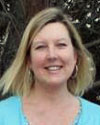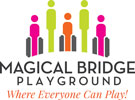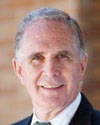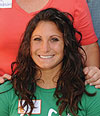|
Lectures |
| Week
1 |
Week
2 |
Week
3 |
Week
4 |
Week
5 |
Week
6 |
Week
7 |
Week
8 |
Week
9 |
Week
10 |
|
|
|
|
|
|
|
|
|
|
|
Thursday, March
4th
|

|
Virtual Field Trip
to the Magical Bridge Playground
Olenka Villarreal
Founder and CEO of
the Magical Bridge Playground |
 |
|
Abstract: Despite the 1990
Americans with Disabilities Act (ADA), it is astounding that most playground
designs still fail to consider the 1 in every 4 of us living with a visible or
invisible disability today. A park outing with her whole family was behind
Olenka's vision to create a new kind of playground, so she could play with both
her daughters who had very different needs. The urgent need to create
playgrounds that would (far) surpass ADA standards was the drive behind the
creation of the Magical Bridge playground whose goal was to bridge the gap
between those with and without disabilities in a most magical way! Olenka and a
team of volunteers raised over $4M to make the first
Magical Bridge Playground a reality
in Palo Alto's Mitchell Park. After opening in June 2015, it received worldwide
recognition as the "nation's most innovative inclusive playground" and was even
featured at the 2019 Davos World Economic Forum. Due to demand for more like
it, Magical Bridge Foundation was created in 2016 and there are now 12 Magical
Bridge destination playgrounds under way locally and around the world. In
addition to the magical spaces they create, the foundation provides truly
inclusive multigenerational programs for every "body" to enjoy - both on and
off the playgrounds.
Biosketch: With an undergraduate
degree from Pomona College and MBA from Golden Gate University, Olenka
Villarreal spent 18 years working with start-up and technology companies in
Silicon Valley. When her second daughter was born with disabilities in 2003,
she turned her focus on improving the quality of life of those with
disabilities. Olenka serves on various boards, including for
AbilityPath and
Life Services Alternatives. Olenka has
received recognition and awards for her pioneering work on Magical Bridge and
holds a few design patents for inclusive playground equipment.
- Contact
information:
- 650/380-1557
- Lecture Material:
- Pre-lecture slides- 10.99 Mb pdf file
- Virtual Field Trip
Material:
- Photos from 2020- 1.56 Mb pdf
file
- Photos - 2.94 Mb pdf file
- Links:
- New Playgrounds:
Morgan Hill -
Redwood City -
Sunnyvale
- Today's Playground - Why isn't it designed for
everyone?
- A Playground for the Entire
Community - Nicole Ofiesh & Lisa Poller - 10/12/2018
- 15
Coolest Playgrounds in the United States
- "Kindness is Magical"
- Palo
Alto’s Magical Bridge Playground serves as model for other
cities
- Sunnyvale
to build an ‘all-abilities’ playground at Fair Oaks
Park
- All-Access
Play
- Jefferson
Award Winner Creates a Playground to Include Kids of All Abilities (with
video 3:06) - 07/09/2014
-
Ground Breaks on Magical Bridge Playground - 06/24/2014
- Palo
Alto breaks ground on Magical Bridge Playground - 06/23/2014
- Magical Bridge Playground on
Facebook
- Stepping Sounds -
George Zisiadis
- Building
a Magical Bridge for All Children - Bay Area Parent
- Magical Bridge Playground in Redwood
City
- Magical
Bridge Playground in Mountain View
- How
to Make Laser Cut Maps of Your City
- Videos:
- A
playground for everyone, no matter your age or ability (video
7:16)
- Building The Bridge Documentary about
Magical Bridge Playgrounds (video 9:48)
- Magical Bridge Foundation's Inclusive
Playground for All Ages and Abilities (video 2:36)
- Intentional Design (TEDx Talk video
20:49)
- Magical Harp at The Magical Bridge
Playground (video 3:05)
- Magical Laser Harp - (video 0:52 by
artist, Jan Lewin)
- Virtual Tour of Magical Bridge Playground
coming to Sunnyvale's Fair Oaks Park (video 1:00)
- We All Deserve a Place to Play - Jill
Asher (TEDx video 16:20)
|

|
What Kind of
Assistive Technology Do You Need if You Break your Neck?
Graham H. Creasey, MD, FRCSEd
VA Palo Alto Health Care System |
This is a virtual field trip
to the VA Palo Alto Health Care System campus in the Spinal Cord Injury
Service.
Abstract: Breaking your neck can
affect nearly every part of your life. Physically, you may be paralyzed from
the neck down, with no feeling in the body, unable to control your bladder or
bowel or sexual function. Obviously, this affects you emotionally and socially
- your education, work, house, travel, and relationships. What can assistive
technology do to change this?
The industrial revolution gave us new
tools, special beds, mattresses, wheelchairs and cushions, catheters, implants,
and many other gadgets. The microelectronic industry has revolutionized
communication and control of equipment in the environment; if you can control a
computer, you can control many other things. What about controlling paralyzed
muscles? What about curing paralysis?
Biosketch: Graham
Creasey was formerly the Chief of the Spinal Cord Injury Service at the
VA Palo Alto Health Care System and Paralyzed Veterans of America Professor of
Spinal Cord Injury Medicine at Stanford University. He attended the University
of Edinburgh Medical School in Scotland and completed specialty and
sub-specialty training and accreditation in Surgery and Spinal Injuries at the
Royal College of Surgeons of Edinburgh. He continues to be actively engaged in
research, mainly on the restoration of bladder, bowel and sexual function using
electrical stimulation.
- Contact
information:
- VA Palo Alto Health Care
System
- Spinal Cord Injury
Service
- 3801 Miranda Ave.
- Room C115, Building 7
- Palo Alto,
CA 94304
- gcreasey -at-
stanford.edu
- Links:
- VA Palo Alto Health Care
System
- Spinal Cord Injury and Disorders
(SCI/D) Center
- Palo Alto Polytrauma
Rehabilitation Center
- Spinal Cord Injury /
Disorder Center
- Virtual Field Trip
Material:
- Photos - 2.12 Mb pdf file
- VA
Assistive Technology Center brochure - 219 Kb pdf file
- Links:
- Meeting
our returning combat veterans in the classroom - Jonathan R. Sills, PhD -
2010
|

|
Adaptive
Sports
Shawna Hill, CTRS, RYT;
Jessica A. Radmilovic, CTRS; and Huy B. Diep
VA
Palo Alto Health Care System |
Abstract: Therapeutic Recreation
is based upon a holistic framework that allows the focus to be on all aspects
of improving an individual’s health and functioning. By providing
structured and unstructured therapy driven services, Therapeutic Recreation may
be used for:
- Improving physical
abilities
- Building confidence
- Promoting greater self
reliance
- Developing and/or enhancing of
leisure awareness and leisure skills
- Strengthening interpersonal
skills
- Empowering veterans to advocate for
positive self growth and change
- Exploring options for rehabilitation
and health through adaptive sports, recreation, and leisure
- Enriching and creating a meaningful
quality of life
Biosketches: Shawna Hill
is a lead recreational therapist at the Department of Veteran’s Affairs
Health Care System in Palo Alto. Her job is to find unique ways to recuperate
injured veterans and help them lead fulfilling, healthy lives. This includes
leading local veterans in wheelchair games, managing athletics for veterans and
patients, or inventing therapeutic activities such as arranging the branches on
a miniature Christmas tree.
Biosketches: Jessica A.
Radmilovic is a lead recreational therapist at the Department of
Veteran’s Affairs Health Care System in Palo Alto.
Biosketches: Huy B. Diep
is a recreational therapist at the Department of Veteran’s Affairs Health
Care System in Palo Alto.
- Contact
information:
- Shawna Hill, CTRS
- Recreational Therapist
- VA Palo Alto Health Care
System
- 3801 Miranda Ave., Building
7
- Palo Alto,
CA 94304
- 650/353-1029
- shawna.hill -at- va.gov
- Links:
- Adaptive Sports
- Painting
with Earl
|